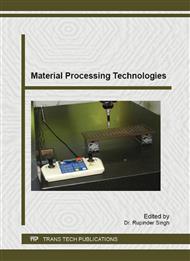[1]
ASTM F2792-10e1, Standard terminology for additive manufacturing technologies,. http: /www. astm. org/Standards/F2792. html, (2010).
Google Scholar
[2]
T.T. Wohlers, Wohlers report 2007: executive sSummary. Annual Worldwide Progress Report, Wohlers Associates Inc., Fort Collins, CO. http: /www. wohlersassociates. com/2001-ExecutiveSummary. pdf, (2007).
Google Scholar
[3]
Z. Shan, Y. Yan, Zhang, Q. Lu, L. Guan, Rapid manufacture of metal tooling by rapid prototyping. Int. J. Adv. Manuf. Technol. 21, 469–475, (2003).
DOI: 10.1007/s001700300055
Google Scholar
[4]
M. Chhabra, R. Singh, Rapid casting solutions: a review. Rapid Prototyp. J. 17(5), 328–350, (2011).
DOI: 10.1108/13552541111156469
Google Scholar
[5]
N. McKenna, Gravity and centrifugal casting of light metal alloys using rapidly produced sand moulds. Thesis (M.E. ), Auckland University of Technology, (2010).
Google Scholar
[6]
Sachs, E.M., Haggerty, J.S., Cima, M.J. and Wiliams, A.P., Three dimensional printing techniques, United States Patent No. US 005340656, (1994).
Google Scholar
[7]
D. Bak, Rapid prototyping or rapid production? 3D printing processes move industry towards the latter. Assembly Autom. 23(4), 340–345, (2003).
DOI: 10.1108/01445150310501190
Google Scholar
[8]
D. Dimitrov, W.V. Wijck, N.D. Beer, J. Dietrich, Development, evaluation, and selection of rapid tooling process chains for sand casting of functional prototypes. Proc. IMechE B 221, 1441–1450, (2007).
DOI: 10.1243/09544054jem728
Google Scholar
[9]
P. Waurzyniak, Rapid metal-rapid manufacturing and rapid tooling for metal parts gain support. Manuf. Eng. 131(3), 49–57, (2003).
Google Scholar
[10]
ZCorporation. ZCast501 Direct metal casting, design guide. http: /www. zcorp. com, (2004).
Google Scholar
[11]
E. Bassoli, A. Gatto, L. Luliano, M.G. Violentte, 3D printing technique applied to rapid casting. Rapid Prototyp. J. 13(3), 148–155, (2007).
DOI: 10.1108/13552540710750898
Google Scholar
[12]
N. McKenna, S. Singamneni, O. Diegel, D. Singh, T. Neitzert, J. George, A.R. Choudhury, and P. Yarlagadda, Direct Metal casting through 3D printing, in A critical analysis of the mould characteristics. in 9th Global Congress on Manufacturing and Management (GCMM2008) in Surfurs Paradise, Australia, (2008).
DOI: 10.1080/14484846.2009.11464576
Google Scholar
[13]
E. Bassoli, E. Atzeni, Direct metal rapid casting: mechanical optimization and tolerance calculation. Rapid Prototyp. J. 15(4), 238–243, (2009).
DOI: 10.1108/13552540910979758
Google Scholar
[14]
J.P. Singh, R. Singh, Investigations for statistically controlled rapid casting solution of brass alloys using three dimensional printing. Int. J. Rapid Manuf. 1(2), 208–221, (2009).
DOI: 10.1504/ijrapidm.2009.029383
Google Scholar
[15]
J.P. Singh, R. Singh, Investigations for statistically controlled rapid casting solution of lead alloys using three dimensional printing.J. Mech. Eng. Sci. 223, 2125–2134, (2009).
DOI: 10.1243/09544062jmes1337
Google Scholar
[16]
R. Singh, Effect of moulding sand on statistically hybrid rapid casting solution for zinc alloys. J. Mech. Sci. Technol. 24(8), 1–7, (2010).
DOI: 10.1007/s12206-010-0523-0
Google Scholar
[17]
R. Singh, M. Verma, Investigation for reducing wall thickness of aluminium shell casting using three dimensional printing. J. Achiev. Mater. Manuf. Eng. 31, 565–569, (2008).
Google Scholar
[18]
R. Kumar, R. Singh, and I.P. Singh, Modeling of dimensional accuracy in three dimensional for light alloy casting, Material science forum, Vol. 808, (Accepted) pp.65-78. Doi. 10. 4028/www. scientific. net/MSF. 808. 65., (2014).
DOI: 10.4028/www.scientific.net/msf.808.65
Google Scholar
[19]
D. I. Lalwani, N. K. Mehta, andP. K. Jain, Experimental investigation of cutting parameters influence on cutting forces and surface roughness in finish hard turning of MDN250 steel, Journal of Materials Processing and Technology, 206, 167–179, (2008).
DOI: 10.1016/j.jmatprotec.2007.12.018
Google Scholar
[20]
S. E. Vieira, R. Hoffmann, "Estatística Experimental. Editora Atlas, São Paulo, (1989).
Google Scholar
[21]
D.C. Montgomery, Design and analysis of experiments, New York, John Wiley & Sons, (1997).
Google Scholar
[22]
R.H. Myers, and D.C. Montgomery, Response surface methodology: process and productoptimization using design of experiments, John Wiley &Sons, New York, (1995).
Google Scholar
[23]
G.E.P. Box, and K.B. Wilson, The exploration and exploitation of response surfaces: some general considerations and examples, Biometrics, Vol. 10, p.16 – 60, (1954).
DOI: 10.2307/3001663
Google Scholar
[24]
C. K. Chauhan, K. C. Joseph, B. B. Parekh, & M. J. Joshi, Growth and characterization of Struvite crystals, National Journal of Pure & Applied Physics, Volume 46, Page No. 507-512, (2008).
Google Scholar
[25]
Madhusudhan, S. Narendranaath, G. C. Mohankumar and P. G. Mukunda, Effect Of Mould Wall Thickness On Rate Of Solidification Of Centrifugal Casting, International Journal of Engineering Science and Technology Vol. 2(11), 6092-6096 ISSN: 0975-5462, (2010).
Google Scholar
[26]
N. Martyushev, Parameters of the dendritic structure of copper alloys, Ivan Franko National University of Lviv Chem. Met. Alloys 3, 197-200, (2010).
DOI: 10.30970/cma3.0152
Google Scholar
[27]
Campbell, J., The New Metallurgy of Cast Metals, Second Edition, Butterworth Heinemann, (2003).
Google Scholar
[28]
Stefanescu, D. M., Science and Engineering of Casting Solidification, Kluwer Academic/Plenum Publisher, (2002).
Google Scholar
[29]
Hemanth, J., Effect of cooling rate on dendrite arm spacing (DAS), eutectic cell count (ECC) and ultimate tensile strength (UTS) of austempered chilled ductile iron, Materials and Design 21, pp.1-8, (2000).
DOI: 10.1016/s0261-3069(99)00052-7
Google Scholar
[30]
Talamantes-Silva, M. A., Rodri, G, A. Talamantes-Silva, J. S., Valtierra, S., and Cola, L., Effect of Solidification Rate and Heat Treating on the Microstructure and Tensile Behavior of an Aluminum-Copper Alloy, The Minerals, Metals & Materials Society and ASM International (2008).
DOI: 10.1007/s11663-008-9204-0
Google Scholar


